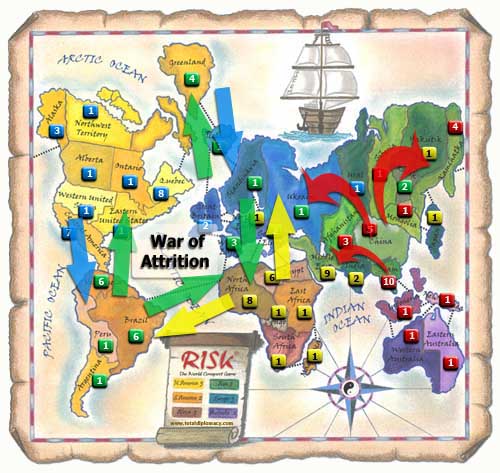By
SuperUser Account :::: Saturday, March 3, 2007
::


Slow Expansion
Analysis:
Green is in a bit of trouble. Making a truce with Yellow at North Africa/Brazil border seems unlikely here. Green's best bet is to make a truce with Blue at Central America/Venezuela border. This allows Green to concentrate on Europe. For Green, South America might be a lost cause with strong opponents on both borders, but it might hold long enough before Green can establish a new stronghold in Europe.
Blue is going to lock down North America and then see what it looks good. It may actually agree to a truce with Green at Central America/Venezuela border, but that will only last as long as it benefits Blue. It is doubtful that Blue has interest in going into Asia, so that leaves Blue moving into Europe or South America. In this case Blue will find itself continuously confronted with Green. Once a fight breaks out, then the chances are that Blue and Green would go into a full scale war with each other.
Yellow sees Green at every border as well and the two are going to fight it out sooner rather than later. The Yellow player may attempt to engage in a diplomacy with Blue over the situation when Green has been eliminated (Green may not like this conversation at all though!). Blue and Yellow may make a deal not to attack each other at Iceland/Greenland border and/or North Africa/Brazil border once Green is out. This deal will be very bad for Red as it means they would divert their armies directly towards Red.
Hence, Red should be very active politically to make sure this does not take place (Suggestion: Say something like "It is extremely unfair to say how you want to divide the world once Green is eliminated. You (Blue and Yellow) should just get on with the fight and then deal with this later"). Of course, Red hopes that by that time a fight has broken between them and that after Green they would turn on each other.
This means a war of attrition will start between Blue and Green and also between Yellow and Green which will most probably lead to Green's elimination. At this point, Red should try to come as a world power since it has hold it's armies and should have good access to other continents to press political pressure.
The move:
In the next turn, Red would not cash in for 10 armies, but rather wait until acquired a fifth card. So with the 5 armies this turn, Red can drop them all in Siam and attack India. This will give Red a strong bulkhead of India and China protecting its Australian continent. Yellow may attack with army in the Middle East, but reinforcing as necessary should minimize that likelihood. Red may cash in for 16 armies in the next turn. China gets 10 armies and heads north to Ural, then west to the Ukraine (it'll likely be still weak). The remaining 6 armies will have to clean up Irkutsk and Siberia. Blue will have likely fortified Alaska by now and a truce should be sought after. If the Ukraine can be taken, that leaves the armies of Afghanistan and India to take the Middle East next turn.
The aim is not to take hold of Asia straight away, but to end up in a positions of power, so when the time comes (such as when Green is eliminated), make a move to secure your place in Asia. Meanwhile having large armies next to Blue and Yellow's continents means that you mean trouble and that you should not be underestimated. In any case, Red should avoid getting into war with both Yellow and Blue once Green is gone.